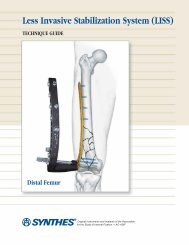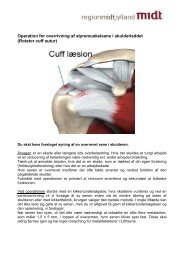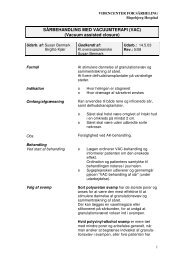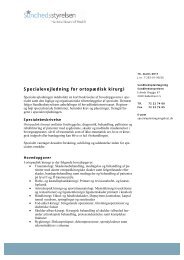TightRope™ Syndesmosis Fixation - DrStorm
TightRope™ Syndesmosis Fixation - DrStorm
TightRope™ Syndesmosis Fixation - DrStorm
Create successful ePaper yourself
Turn your PDF publications into a flip-book with our unique Google optimized e-Paper software.
5<br />
The construct is secured with three half-hitches. The<br />
suture ends are cut about 1 cm long to allow the knot<br />
and suture to lay down, reducing knot prominence.<br />
B<br />
Lateral<br />
Left leg<br />
Anterior<br />
Posterior<br />
Medial<br />
A second TightRope should be used to treat Maisonneuve<br />
injuries, or if further syndesmosis stability is required. The<br />
second TightRope should be placed 1 cm above the first,<br />
with slight axial divergence to increase rotational stability.<br />
(see illustration B and x-ray insets)<br />
A<br />
Repair is complete using one TightRope.<br />
Surgical Technique<br />
Postoperative Management<br />
Following wound closure, immobilize the ankle in the neutral<br />
position in a below-knee cast, nonweight-bearing for the<br />
first two weeks. Depending on fracture fixation stability and<br />
satisfactory wound healing, partial weight-bearing (50% body<br />
weight) may then be permitted in cast or walker boot, until<br />
six weeks postoperatively. Full weight-bearing can be allowed<br />
out of cast at six weeks.<br />
Implant Removal<br />
Routine removal of the TightRope is not required. If, for<br />
any reason it needs removal; small incisions over both buttons<br />
and cutting the suture makes removal of the buttons<br />
and suture easy.






